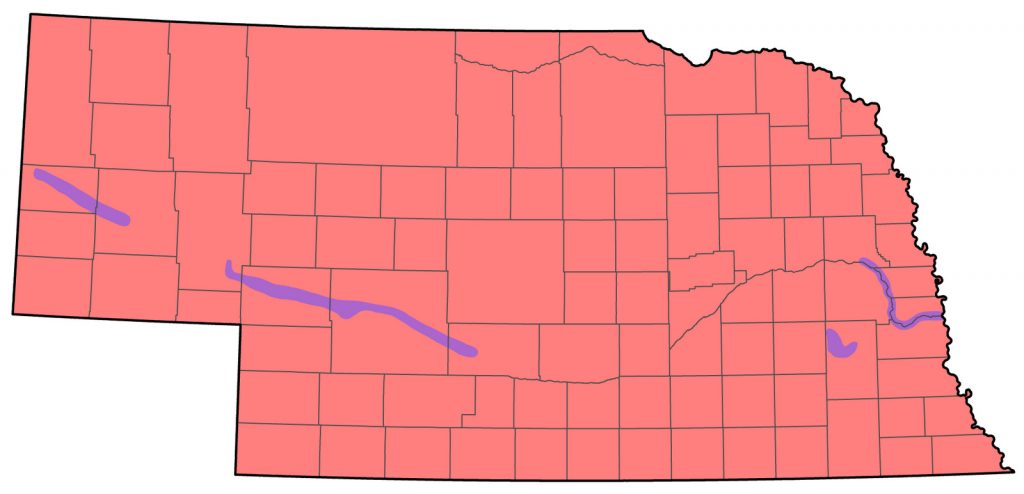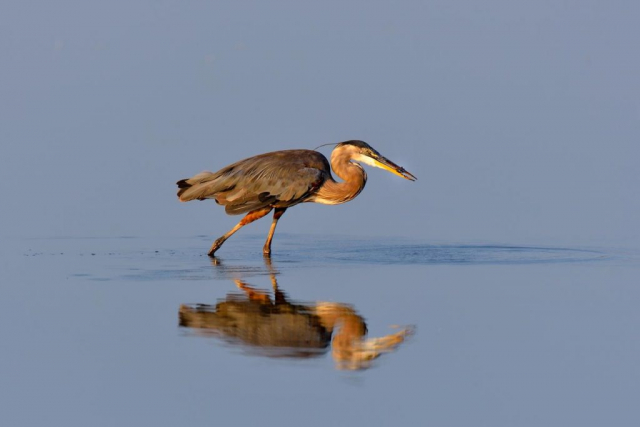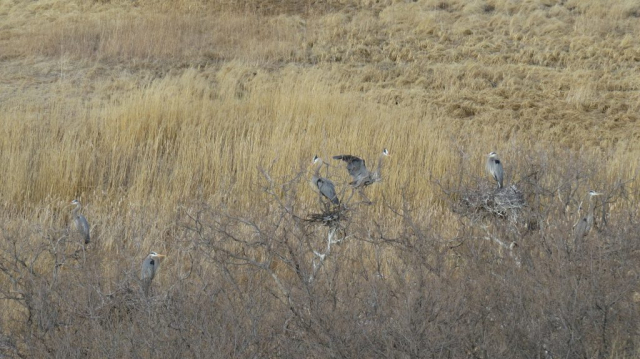Ardea herodias wardi
Status: Common regular spring and fall migrant statewide. Locally common regular breeder west and central, uncommon east. Locally uncommon regular winter visitor Platte and North Platte river valleys, rare elsewhere.
Documentation: Specimen: UNSM ZM10615, 24 Jun 1912 Halsey, Thomas Co.
Taxonomy: Five subspecies are recognized (Vennesland and Butler 2020; AviList 2025), western North American fannini, northern North American herodias breeding south to the Dakotas, Indiana, and the Carolinas, wardi breeding south of herodias from Nebraska southward, cognata of the Galapagos Islands, and occidentalis of Florida.
Although subspecies diagnosis is unclear in many cases, Vennesland and Butler (2020) consider most breeding Great Blue Herons in Nebraska to be wardi, although some intergradation might be expected in northern Nebraska.
Older records relied on taxonomic assignments that under current taxonomy may be equivocal; it has, for example, been thought that Nebraska had only two records of wardi: one collected 18 Aug 1914 at Inland, Clay Co (Brooking, Notes), probably a post-breeding wanderer, and another reported from Frontier Co (AOU 1957). Swenk (1919) stated herodias to be a “common summer resident and breeder”, while wardi was a “straggler from the south”. Swenk’s (Notes Before 1925) report of two specimens of herodias in the Black collection that approached wardi in size is suggestive of some intergradation; under current taxonomy, these were probably indeed wardi.
Spring: Most years, wintering birds make spring arrival difficult dates to determine, but there is a noticeable increase in numbers around the spring thaw, typically in late Feb-early Mar. Males arrive early at rookeries, such as those standing on nests at Sutherland Reservoir, Lincoln Co by 26 Feb 2006, Franklin Co by 4 Mar 2012, and Lake Ogallala, Keith Co 6 Mar 2016. Nine at Harlan County Reservoir, Harlan Co 22 Feb 2004 may have been early migrants.
- High counts: 85 at a pond in York Co 13 Apr 2018, 50 at Crescent Lake NWR, Garden Co 10 Apr 1996, 50 around Lake McConaughy, Keith Co 13 Apr 1997, and 48 at Crescent Lake NWR 14 May 1995.
Summer: This species breeds statewide in colonies containing up to 100 or more nests, although most contain around 10 nests. A large colony in Dawson Co, near Interstate Highway 80, had 90+ nests 11 May 2002 (Mollhoff 2004), and one in Cass Co had 94 nests 23 Mar 2011. Ducey (1988) indicated breeding records since 1960 in 30 counties statewide. In 2001, at least 20 active colonies were known to be distributed across the state (Silcock, unpublished data). Several colonies were in the Keystone Lake, Lake McConaughy area (Brown et al 1996, Rosche 1994), and, in 1994, Rosche located 9 rookeries with 81 nests in Webster, Harlan, Hitchcock, Cheyenne, Kimball, Sheridan, and Sioux Cos.
A group of seven nests in power transmission lines in Sarpy Co in 2003 was removed due to the potential for the birds’ droppings causing power outages (Omaha World Herald). Entire colonies of incubating adults have been recorded as late as 18-20 Jul, suggesting either late nesting or re-nesting attempts.
- Breeding Phenology:
Nest-building: 26 Feb-10 Jun
Incubation: 14 Mar-20 Jul
Nestlings: 8 May-21 Jul - Fledglings: 29 Jul
Fall: In late summer, most conspicuously in Jul, post-breeding mixed-age flocks begin to form, probably including birds from further north as well as local post-breeding wanderers. Such late summer flocks include 147 in Hall Co 22 Jul 2020 and 85 at Jack Sinn WMA, Lancaster Co 22 Jul 2012. Non-point counts include 125 along the Missouri River Valley in southeast Nebraska 25 Jul 2010, and 60 in the eastern Rainwater Basin 24 Jun 2005.
There is no clear fall movement, although about half of departure dates fall in Oct, and most Great Blue Herons are restricted to the Platte River Valleys and southward by Dec.
Returns from juveniles banded in Nebraska indicate that most migrate directly south during winter periods into Oklahoma, Texas and Mexico.
- High counts: 175 at Cedar Vue, Lake McConaughy, Keith Co 6 Sep 2024, 160 at Harlan County Reservoir, Harlan Co 20 Sep 2001, and 119 at Lake McConaughy 20 Sep 1998.
Winter: Although there are winter records statewide, overwintering is essentially limited to the Platte and North Platte river valleys, with fewest sightings Jan through mid-Feb. Regular sightings occur near Lewellen and below Keystone Lake along the North Platte River (Rosche 1994), where 17 were present 1 Jan 2017, and 15 on 29 Jan 2000; 15 were at nearby Sutherland Reservoir, Lincoln Co 2 Jan 2015. During periods of severe winter weather, all birds probably leave the state.
Images
Abbreviations
NWR: National Wildlife Refuge
UNSM: University of Nebraska State Museum
WMA: Wildlife Management Area (State)
Literature Cited
American Ornithologists’ Union [AOU] . 1957. The AOU Check-list of North American birds, 5th ed. Port City Press, Baltimore, Maryland, USA.
AviList Core Team, 2025. AviList: The Global Avian Checklist, v2025. https://doi.org/10.2173/avilist.v2025.
Brooking, A.M. Notes. Bird specimen records. Manuscript in NOU Archives, University of Nebraska State Museum, Lincoln, Nebraska, USA.
Brown, C.R., M.B. Brown, P.A. Johnsgard, J. Kren, and W.C. Scharf. 1996. Birds of the Cedar Point Biological Station area, Keith and Garden Counties, Nebraska: Seasonal occurrence and breeding data. Transactions of the Nebraska Academy of Sciences 23: 91-108.
Ducey, J.E. 1988. Nebraska birds, breeding status and distribution. Simmons-Boardman Books, Omaha, Nebraska, USA.
Mollhoff, W.J. 2004. The 2002 Nebraska Nesting Report. NBR 72: 153-158.
Rosche, R.C. 1994. Birds of the Lake McConaughy area and the North Platte River valley, Nebraska. Published by the author, Chadron, Nebraska, USA.
Swenk, M.H. 1919. The Birds and Mammals of Nebraska. Contributions of the Department of Entomology No. 23. Lincoln, Nebraska.
Swenk, M.H. Notes before 1925. Bird notes from A.M. Brooking of Hastings, C.A. Black of Kearney, and B.J. Olson of Kearney, based chiefly on their collections, up to January 1, 1925. Typed manuscript in the Nebraska Ornithologists’ Union Archives, University of Nebraska State Museum, Lincoln, Nebraska, USA.
Vennesland, R.G. and R.W. Butler. 2020. Great Blue Heron (Ardea herodias), version 1.0. In Birds of the World (A. F. Poole, Editor). Cornell Lab of Ornithology, Ithaca, NY, USA. https://doi.org/10.2173/bow.grbher3.01.
Recommended Citation
Silcock, W.R., and J.G. Jorgensen. 2025. Great Blue Heron (Ardea herodias wardi). In Birds of Nebraska — Online. www.BirdsofNebraska.org
Birds of Nebraska – Online
Updated 13 Jul 2025


